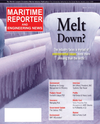
Page 42: of Maritime Reporter Magazine (May 2012)
The Green Ship Edition
Read this page in Pdf, Flash or Html5 edition of May 2012 Maritime Reporter Magazine
Middle Eas42Maritime Reporter & Engineering News Beyond Compliance Proactive Risk Management Pays Dividends for Vela International Operating margins for most marine op- erators are getting thinner. It really does- n?t matter what trade segment that you are in. Faced with the task of increasing operational efficiencies, marginal play- ers can perhaps be forgiven if, at the same time, they fail to apply new tech- nologies and respond to increased envi- ronmental regulations, while also maintaining the latest operational risk management practices. That risky prac- tice is usually driven by financial pres- sures and rarely ends well. Not everyone, however, is willing to cut corners on the way to financial success. One such operator, Vela International Marine Limited, the tanker owner and operator subsidiary of Saudi Aramco ,talked with Maritime Reporter about the collective challenges and of its philoso- phy of ?going beyond compliance? that has kept them ahead of the curve in terms of operating a safe and innovative fleet. In April, Mohammed S. Gusaier, Presi- dent & CEO, Vela International Marine Limited weighed in on six risk manage- ment practices that someday may bear fruit on the financial side of the equation, as well.Environmental Compliance: According to Gusaier, Vela takes its en- vironmental stewardship seriously. He explains, ?As an organization we take an active role within industry to help guide and shape future legislation rather than feel new regulations are being placed upon us. Vela takes pride in partnering with industry as legislation is being con- sidered and developed.? Gusaier goes on to describe Vela?s in- volvement with the EU Low-Sulphur Di- rective (Directive 1999/32/EC as amended by Directive 2005/33/EC) which came into force on 01 January2010. ?Vela was able to make timely, de- tailed plans to meet this directive by in- vesting time and effort to understand the scope, to explore the implications on our business model and to investigate the im- pact on the people and equipment onboard our vessels,? he added. Specific ac- tion plans were developed and tested in good time and Vela achieved compliance without difficulty. Operational Innovation As MR went to press, Vela was actively evaluating a full range of measures to im- prove operational efficiency. These meas- ures, centered on the reduction of fuelconsumption and the reduction of green-house gases included main engine opti- mization, low friction hull coatings, air lubrication systems, propeller inflow modifications, and dynamic trim sys- tems. Beyond this, Gusaier reported that the use of advanced mathematical algo- rithms for converting raw vessel per- formance data into normalized andbaselined data for the detailed investiga- tion of vessel and fleet performance was also being used. New Regulations/ Applying New Technology: Gusaier told MR, ?We currently oper- ate vessels with IMO Tier II compliant engines and for any newbuild projects, we will work with engine manufacturers to achieve IMO Tier III compliance whereby NOx performance will be im-proved by 80%.? He explained further, ?Our SOx emissions are governed by the current fuel sulfur legislation and we have invested a great deal of effort to en- sure that we comply with both the letterand the spirit of this legislation. Vela uses accredited bunker suppliers as well as third party bunker surveyors and inde- pendent bunker sample analyzes to see that the fuel logistics chain is well man-aged and optimized. Looking to the fu-ture we are assessing the suitability of arange of abatement technologies to fur- ther reduce SOx emissions.? Addressing the impending ballast water legislation, both from Europe and the United States, Vela developed a roadmap to facilitate implementation once the Bal- last Water Convention is ratified. Vela?s CEO also pointed to BWT requirementsthat will kick off starting December 2013. ?We share the industry?s concern over sampling issues (detailed in G2 of the Convention) and trust that these will be addressed at the forthcoming IMOMarine Environmental Protection Com- mittee (MEPC) meetings.? At Vela, the pre-engineering phase of ballast water treatment is already underway. Energy Efficiency Design Index (EEDI): managing greenhouse gases The IMO Energy Efficiency Design Index (EEDI) is a benchmarking scheme and an indication of a merchant ship?s CO2 output in relation to its value for so- ciety. This is one of the first steps of IMO?s technical measures to reduce CO2 emissions from shipping. The EEDI com- pares theoretical CO2 emissions andtransport work of a vessel and will even- tually be benchmarked against an IMO- set requirement. While EEDI is still a work in progress, says Vela?s Gusaier, his group is actively participating in industry work groups and forums. He adds, ?When new (Vela) vessels are planned, the EEDI formula will be applied alongwith the incremental improvement tar- gets.? Ship Energy Efficiency Management Plan (SEEMP): Vela?s Version Gusaier eagerly addressed this aspectof Vela?s operational structure. ?Our ship specific Ship Energy Efficiency Manage- ment Plan (SEEMP) is an integral part of our environmental management plan and incorporates the principles of ISO 14001and ISO 50001. More specifically, it has been developed using IMO circular MEPC.1/Circ.683 and MEPC 62/INF.10 8 as guidance.? He went to explain that the operational procedures which go along with theOne of Vela?s double hull VLCCs built in 2002 at Hyundai HeavyIndustries Shipyard in Korea MR May 12 # 6 (42-49):MR Template 5/7/2012 2:50 PM Page 42

 41
41

 43
43
